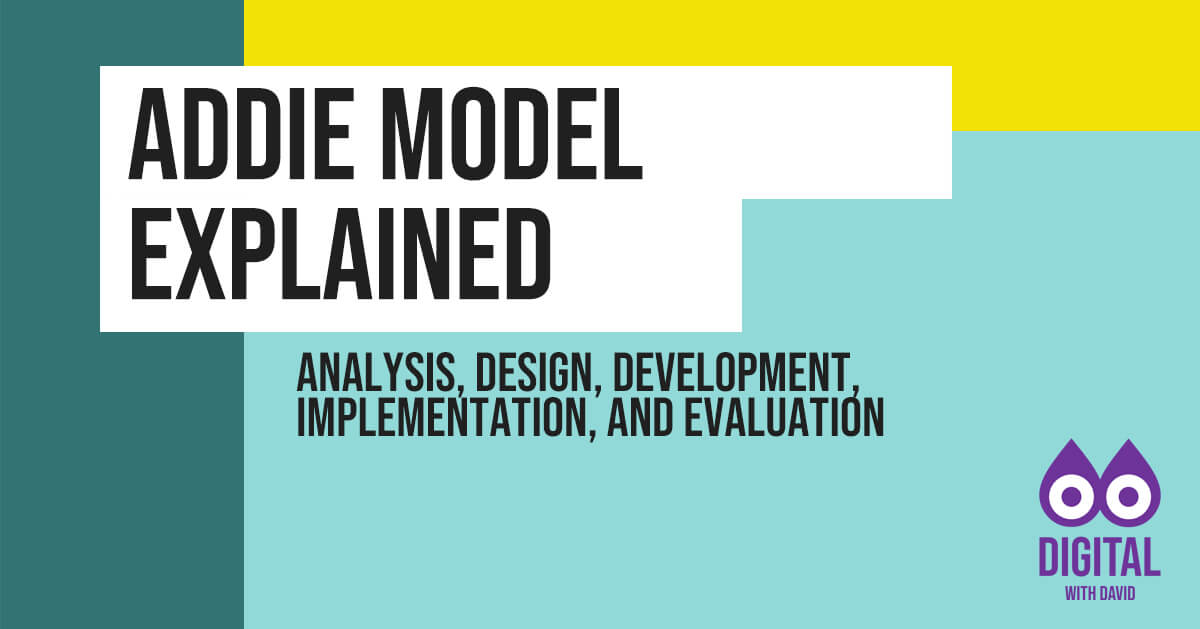The ADDIE model is a popular instructional design framework used by educators, trainers, and instructional designers to create effective and engaging learning experiences.
ADDIE stands for Analysis, Design, Development, Implementation, and Evaluation, which are the five key phases of the model.
Analysis phase
Main activities
- Identify the learning needs of the target audience, such as their existing knowledge and skills, their learning preferences, and any knowledge gaps or misconceptions.
- Define the learning objectives, which specify what the learners should know, understand, or be able to do after completing the learning experience.
- Identify any constraints or limitations that may affect the design process, such as available resources, time constraints, and technical requirements.
- Analyse the context in which the learning experience will take place, including the organisational culture, the learners’ work environment, and any external factors that may affect the learning experience.
- Conduct a task analysis, which involves breaking down complex tasks into smaller components and identifying the knowledge and skills required to perform each task.
Expected outcomes
- A clear understanding of the learning needs and goals of the target audience.
- A set of measurable learning objectives that align with the goals of the learning experience.
- A comprehensive analysis of the context and constraints of the learning experience.
- A thorough understanding of the tasks that learners will need to perform after completing the learning experience.
Outputs
- Learning needs analysis report
- Learning objectives document
- Constraints and limitations report
- Context analysis report
- Task analysis report
Design phase
Main activities
- Translate the learning objectives into specific instructional strategies, such as lectures, discussions, activities, or assessments.
- Develop a detailed outline or storyboard of the learning experience, including the sequence of topics, the activities and assessments that will be used, and the resources that will be required.
- Determine the format and delivery method of the learning experience, such as classroom-based, online, or a combination of both.
- Develop a plan for evaluating the effectiveness of the learning experience, including the criteria for success and the methods for data collection.
Expected outcomes
- A clear understanding of the instructional strategies that will be used to achieve the learning objectives.
- A comprehensive outline or storyboard of the learning experience that aligns with the goals of the learning objectives.
- A plan for the format and delivery of the learning experience that is suitable for the target audience.
- A plan for evaluating the effectiveness of the learning experience that aligns with the goals of the learning objectives.
Outputs
- Instructional strategy document
- Learning experience outline or storyboard
- Format and delivery plan
- Evaluation plan
Development phase
Main activities
- Create the learning materials and resources that were outlined in the Design phase, such as presentations, handouts, videos, and activities.
- Develop any necessary technology or multimedia components, such as interactive simulations, animations, or podcasts.
- Review and test the learning materials and resources to ensure they are accurate, engaging, and effective in achieving the learning objectives.
- Make any necessary revisions or adjustments to the learning materials and resources based on feedback from peers, experts, or learners.
Expected outcomes
- A complete set of learning materials and resources that align with the goals of the learning objectives.
- Accurate, engaging, and effective learning materials and resources that are appropriate for the target audience and the learning context.
- A thorough review and testing process ensures the quality of the learning materials and resources.
- A revised set of learning materials and resources that address any issues or concerns that were identified during the review and testing process.
Outputs
- Learning materials and resources, such as presentations, handouts, videos, and activities
- Technology or multimedia components, such as interactive simulations, animations, or podcasts
- Review and test reports
- Revised learning materials and resources
Implementation phase
Main activities
- Deliver the learning experience to the target audience according to the format and delivery plan that was outlined in the Design phase.
- Monitor the progress and engagement of the learners during the learning experience.
- Provide support and guidance to the learners as needed, such as answering questions, providing feedback, or facilitating discussions.
- Collect data and feedback on the effectiveness of the learning experience, such as assessments, surveys, or observations.
Expected outcomes
- Successful delivery of the learning experience according to the format and delivery plan.
- Active engagement and progress of the learners during the learning experience.
- Adequate support and guidance are provided to the learners to facilitate their learning.
- Relevant and meaningful data and feedback are collected on the effectiveness of the learning experience.
Outputs
- Completed learning experience delivered to the target audience
- Progress and engagement reports
- Support and guidance documentation
- Data and feedback reports
Evaluation phase
Main activities
- Review the data and feedback collected during the Implementation phase to assess the effectiveness of the learning experience.
- Identify strengths and weaknesses of the learning experience and its components, such as the learning objectives, materials, delivery, and support.
- Use the data and feedback to make recommendations for improvements to the learning experience.
- Communicate the findings and recommendations to stakeholders, such as the learners, instructors, and sponsors.
Expected outcomes
- A comprehensive evaluation report that outlines the strengths and weaknesses of the learning experience and its components.
- Recommendations for improvements to the learning experience and its components that are based on relevant data and feedback.
- Stakeholders are informed of the findings and recommendations and are prepared to take action to improve the learning experience.
Outputs
- Evaluation report
- Recommendations for improvements
- Stakeholder communication materials

Keep reading
